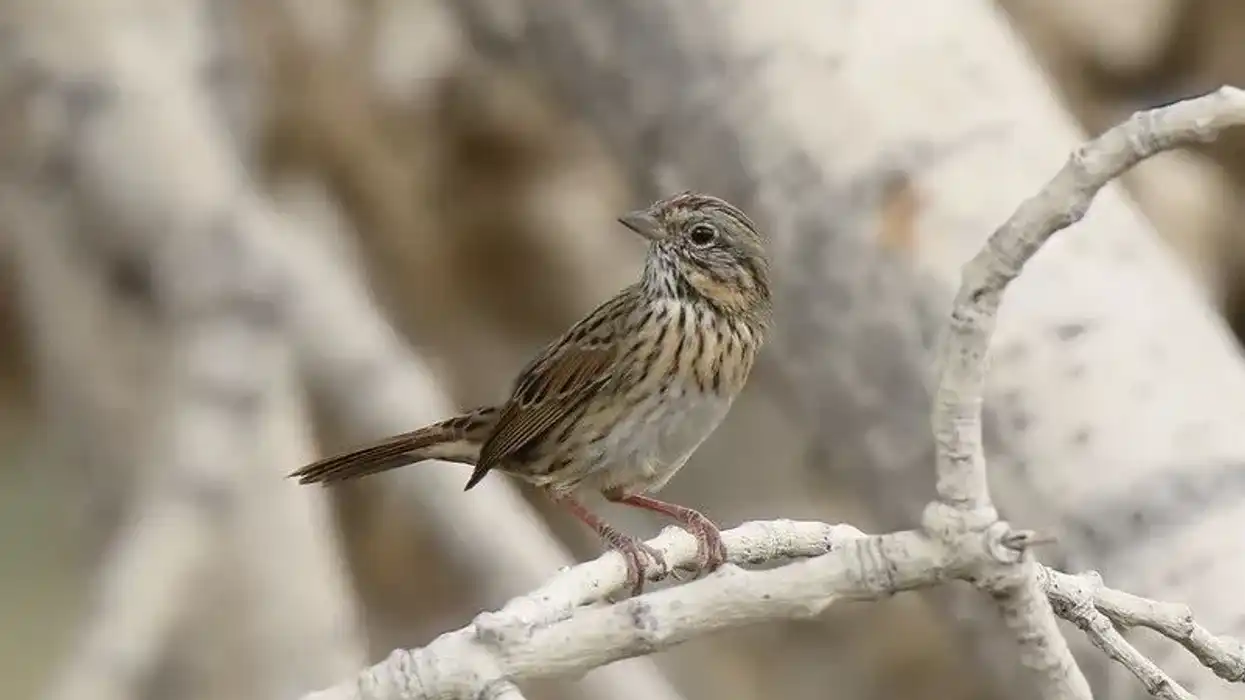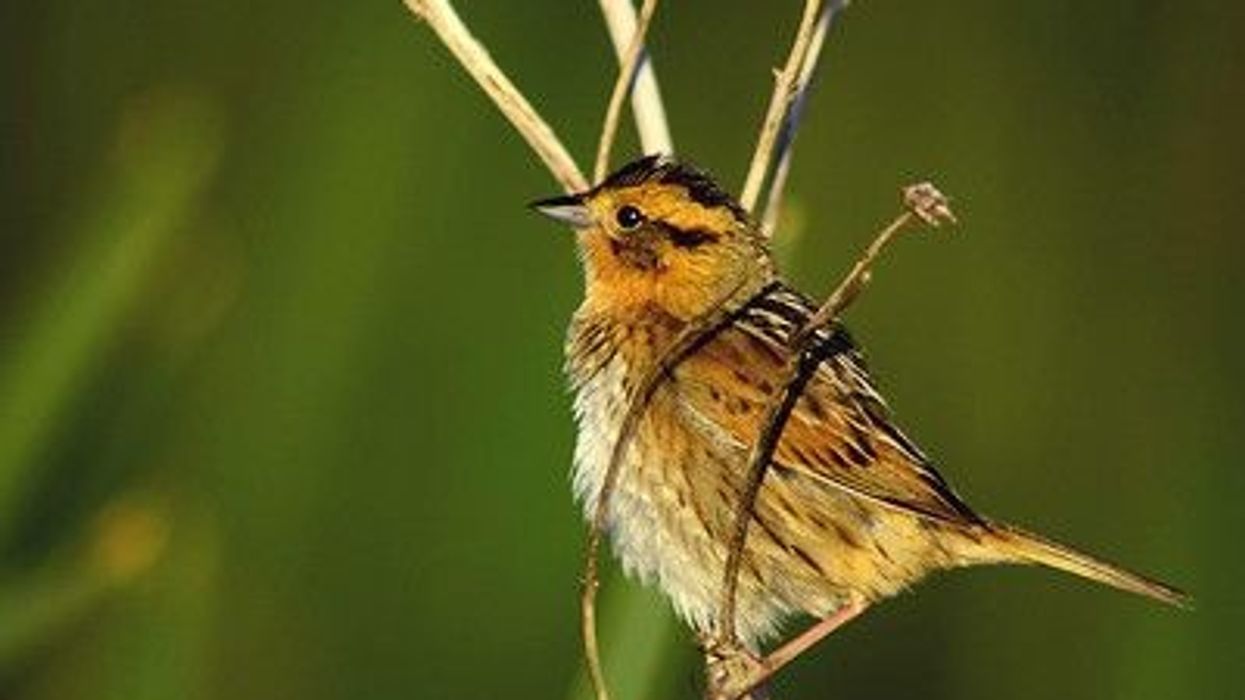Lincoln's sparrow, Melospiza lincolnii, is a common breeder which can normally be spotted in North America. These birds, during migration, fly either to the west region or the central region of America, as far as New Mexico and Oregon.
The male of the species is known for his singing talent. The song is usually heard around during the breeding season.
Their song is sweet and similar to that of swamp sparrows. These sparrows' primary nesting habitats are sedge, willow, and alder. The singing song compatibility is also often related to the song sparrow, which is a sparrow species of the New World.
Lincoln's bird is a little sparrow with a beautiful and graceful appearance. Lincoln's bird has a round midsection and a round crest with beautiful crown plumage close to the eyes. According to the IUCN, these birds are of the Least Concern.
During the migration or winter season, they live alone, whereas, during the summer or breeding season, you may see them in a pair because these birds are monogamous by nature. Melospiza melodia and Melospiza georgiana are two similar species of the genus Melospiza.
These closely related species are members of the same family and exhibit almost identical behavior. The diet of these birds is insectivorous.
Lincoln's Sparrow Interesting Facts
What type of animal is a Lincoln's sparrow?
Lincoln's sparrow is a tiny, ground-feeding bird that prefers to stay close to dense vegetation. Males sing during the breeding season. They sing from the tree's upper branch and from the inside of the shrub. They fly to the west or central regions of America during the migration period.
What class of animal does a Lincoln's sparrow belong to?
Lincoln's sparrow belongs to the family of Passerellidae and the genus Melospiza. The scientific name under which they are recognized is Melospiza lincolnii.
They belong to the class of Aves who are often involved in a migration after the breeding season. In the genus Melospiza, similar species are named Melospiza melodia and Melospiza georgiana. These similar species are from the same family and almost have similar behavior.
How many Lincoln's sparrows are there in the world?
The exact number of Lincoln's sparrow who comes from the family of Passerellidae is unknown as their conservation status is of Least Concern.
Where does a Lincoln's sparrow live?
Lincoln's sparrow lives in the northernmost regions of North America. Along with their two other similar species, they are found in Alaska, in the west of America. During migration, they can be seen in Mexico, Central America, and the Dominican Republic.
What is a Lincoln's sparrow's habitat?
Sedge, willow, and alder are the primary breeding habitats of these sparrows. They can also be found in aspen, cottonwood, and willow woodlands. Lincoln's sparrows while they migrate use wooded remnants, thickets, and brushy fields. They forage in pine-oak forests, tropical forests, shrubby fields, weedy pastures, and tropical scrubland during the winter in the west.
Who do Lincoln's sparrows live with?
Lincoln's sparrows are monogamous by their nature during the breeding season, while they live solitarily during the winter season, which is also a time period before which migration is quite evident in them. The clutch size of these sparrows is three to five.
How long does a Lincoln's sparrow live?
The longevity of Lincoln's sparrow is unknown and has not been evaluated, but these birds with a diet of worms and small insects must live on an average of about four years.
How do they reproduce?
Lincoln's sparrows are ground feeders, and along with that, these birds make the nest on the ground. The female birds lay their eggs in a grassy lot or meadow, usually within the bounds of a thick hedge of sedges and blooming flowers such as buttercup and corn lily.
A female will often dig a tiny hole in the ground to put her nest in before she begins to construct one.
The female bird then wraps willow bark and dried sedges, grasses, and rushes together to form a cup-shaped nest over the next two to three days. The female wraps the interior of the nest with soft vegetation after she has finished the groundwork.
The nest of these birds is 4 in (10 cm) wide and 2 in (5 cm) tall on its completion.
The average clutch size of these bird species is three to five, while summer is the breeding season when male Lincoln's sparrows sing a song to attract the female sparrows. It is evident from their behavior that they sing a song during the breeding season.
What is their conservation status?
The conservation status of these North American birds, whose migration is evident during the winter season, is of Least Concern as per the listing by IUCN.
Lincoln's Sparrow Fun Facts
What do Lincoln's sparrows look like?
Lincoln's sparrow is a thick black brown and gray on the outside, with golden edging on its tail along with wings. It has a beautiful golden breast and flanks, featuring faint dark striping that dissipates into a whitish underbelly.
Lincoln's bird is a little sparrow with a delicate look. Lincoln's bird has a round stomach as well as a round head, but when it lifts its crown plumage, the rear of its head frequently seems peaked or ruffled with fine streaks.
It has a short tail and a slightly narrower pointed beak compared to other sparrow species. The eye-ring of an immature Lincoln's sparrow, Melospiza lincolnii, is pale or absent.
How cute are they?
These birds are no doubt cute because of their small size and singing talent. The young birds are attractive due to their crown plumage.
How do they communicate?
Lincoln's sparrows are also known for their singing talent. The male birds during the summer or breeding season are known to attract the young females by singing a song for them so that they can form a pair.
How big is a Lincoln's sparrow?
Lincoln's sparrow has a wide wingspan of 7.5-8.7 in (19-22 cm) and is 5-6 in (13-15 cm) in length.
How fast can a Lincoln's sparrow fly?
The flying speed of these birds has not been recorded or estimated, but as these birds are involved in the migration process during the winter season, they must have flown at a good speed. One special thing about a sparrow, in general, is its flying speed which is anywhere between 24-31 mph (38.5-50 kph).
How much does a Lincoln's sparrow weigh?
Lincoln's sparrow weighs around 0.6-0.7 oz (17-19 g).
What are the male and female names of the species?
The male and female of the species do not have different names and are known by their common name, Lincoln's sparrow, Melospiza lincolnii.
What would you call a baby Lincoln's sparrow?
The baby of Lincoln's sparrow, Melospiza lincolnii, is called a hatchling.
What do they eat?
The diet of these birds usually consists of small insects and worms. Lincoln's Sparrows consume a variety of insects, including flies, moths, beetles, caterpillars, aphids, and leafhoppers. These bird species prefer to rest on the ground, where they scratch at vegetation to expose insects and seeds or pluck food off low bushes.
Are they poisonous?
No, these young birds, or sparrows, with a dark eye ring from the family of Passerellidae are not poisonous or dangerous to humans.
Would they make a good pet?
The artificial life for these crown plumage birds would not be an ideal environment for them to live in. These sparrows live in an open habitat of open ground with shrubs, and their migration is quite evident in them. As a result, allowing them to live in their natural habitat is the best option for them.
Did You Know...
The size of an egg laid is 0.7-0.9 in (1.7-2.2 cm) and the incubation period lasts for 10–13 days. During the winter season, they live their lives in solitude, while during the breeding season in summer, these sparrows form monogamous pairs.
During the winter season, these bird species consume tiny seeds while on rare occasions, can be seen feeding on seeds from ground feeders.
How did Lincoln's sparrow get its name?
Lincoln's sparrow is named after Thomas Lincoln, who went on an expedition with John James Audubon and shot this species. The sparrow was discovered in Natashquan, Quebec, by the research team, and Mr. Lincoln was the only one who brought back a specimen of the sparrow for further study or research.
What is the difference between Lincoln's sparrow and swamp sparrow?
Lincoln's sparrow and swamp sparrow both belong to the New World sparrow species that are related to the song sparrow. When looking at Lincoln's sparrow vs. swamp sparrow, Lincoln's sparrow has a wide geographical location, from Canada and Alaska to the western and central parts of America.
The swamp sparrow is found in central Canada and North America. The adult Lincoln's sparrows have a paler buffy color and eye-ring to the upper body than swamp sparrows.
Immature swamp sparrows look a lot like immature Lincoln's sparrow with fine strikes. They both are from the same genus.
*We've been unable to source an image of Lincoln's sparrow and have used an image of a lesser swamp warbler instead. If you are able to provide us with a royalty-free image of Lincoln's sparrow, we would be happy to credit you. Please contact us at hello@kidadl.com.










